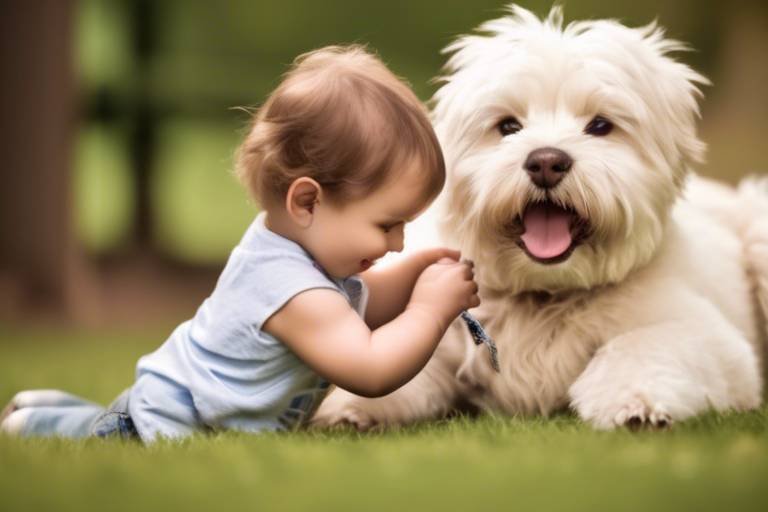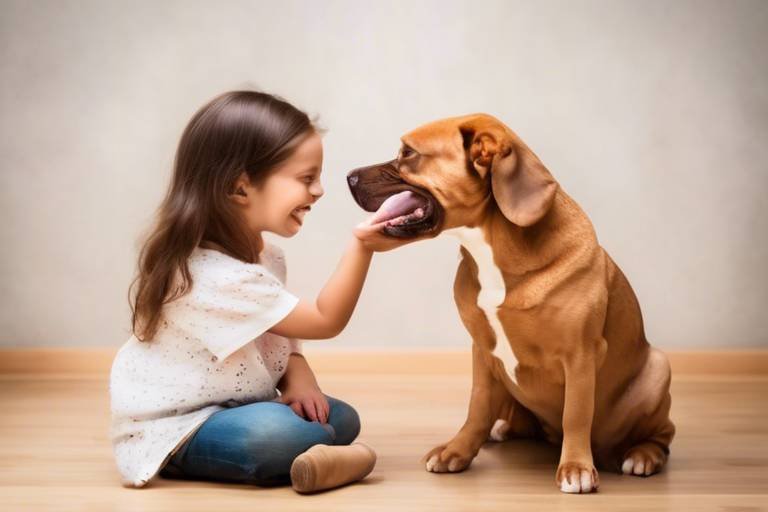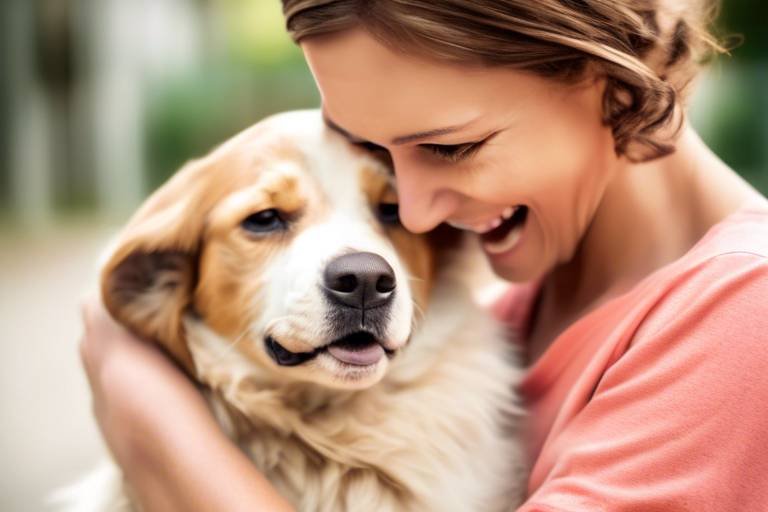The Best Practices for Introducing a New Pet to Your Family
Bringing a new pet into your home is like opening a new chapter in a book—exciting, full of possibilities, and slightly overwhelming. As you embark on this journey, it's essential to ensure a smooth transition for your furry friend. You want to create a loving and secure environment that will foster a positive relationship between your pet and your family. So, how do you achieve this? Let’s dive into some effective strategies that will help you introduce your new pet to your family seamlessly.
Before anything else, it’s vital to understand your new pet's needs. Just like humans, pets have their own unique requirements and personalities. Whether you’ve adopted a playful puppy or a serene cat, recognizing their basic care requirements is crucial. For instance, consider their dietary needs, exercise routines, and social interactions. Each pet has different behavioral traits; some may be more independent, while others thrive on companionship. A good starting point is to research the specific breed or species you’ve welcomed into your home. This knowledge will help you create a comfortable environment tailored to your pet's needs, ensuring they feel safe and loved from day one.
Now that you have a grasp of your new pet's needs, it’s time to prepare your home. Think of your living space as a blank canvas that you need to paint with safety and comfort. Before your pet arrives, make necessary adjustments to your home to ensure it’s pet-friendly. This includes removing any hazardous items that could pose a threat to your new companion. Additionally, creating a designated area for your pet—a cozy corner with their bed, toys, and water—will give them a sense of belonging right from the start.
Pet-proofing your home is a critical step in ensuring the safety of your new furry friend. Just like baby-proofing for a toddler, you need to identify potential hazards that could lead to accidents. Start by taking a thorough walk around your house and look for:
- Exposed electrical cords
- Small objects that can be swallowed
- Houseplants that may be toxic to pets
- Cleaning supplies stored within reach
By mitigating these risks, you can protect both your pet and your belongings, allowing everyone to relax and enjoy their new family member.
Identifying and securing hazardous items is crucial for your pet's safety. Store dangerous substances, such as cleaning products and medications, in high cabinets or locked drawers. Additionally, consider using childproof latches on cabinets that contain items your pet might be curious about. Remember, pets are naturally inquisitive, and their exploration can lead to unexpected accidents if precautions aren’t taken.
Creating safe spaces for your pet can promote comfort and reduce anxiety. Set up areas where your pet can feel secure and relaxed within your home. This could be a quiet room with their bed and favorite toys or a cozy nook where they can retreat when feeling overwhelmed. Providing these safe spaces will help your new pet adjust to their surroundings and feel more at home.
Now that your home is ready, it’s time to introduce your new pet to your family members. This process requires careful planning to ensure that everyone, including children, interacts positively with the new addition. Teach your family about proper pet etiquette—how to approach the pet, when to give space, and how to read their body language. Remember, patience is key. Allow your pet to acclimate at their own pace, and supervise interactions until you’re confident that everyone is comfortable.
Once your pet is settled in, establishing a consistent routine is vital for their adjustment. Just like humans thrive on routine, pets feel more secure when they know what to expect. Create a daily schedule that includes feeding times, exercise, and training sessions. This routine will not only help your pet adapt but also strengthen the bond between you and your new companion.
Proper nutrition is essential for your pet's health and well-being. Research the dietary needs specific to your pet’s breed or species, and choose high-quality food that meets those requirements. Remember to establish a regular feeding schedule to help your pet feel secure and satisfied. Keep an eye on their weight and overall health, and consult your veterinarian if you have any concerns.
Training your pet is crucial for a harmonious household. Start with basic commands like “sit,” “stay,” and “come.” Positive reinforcement, such as treats and praise, can work wonders in teaching your pet appropriate behaviors. Consistency is key, so make sure everyone in the household is on the same page when it comes to training methods. This will help your new pet learn faster and feel more confident in their new environment.
Q: How long does it take for a pet to adjust to a new home?
A: Every pet is different, but generally, it can take anywhere from a few days to several weeks for a pet to fully adjust to a new environment. Patience and consistency are crucial during this time.
Q: What should I do if my pet is showing signs of anxiety?
A: If your pet seems anxious, provide them with a safe space and allow them to explore at their own pace. You might also consider consulting a veterinarian for advice on anxiety-reducing techniques.
Q: How can I introduce my new pet to my existing pets?
A: Gradually introduce your new pet to your existing pets in a controlled environment. Use leashes or crates to manage the initial encounters and supervise all interactions until you’re confident they can coexist peacefully.

Understanding Your New Pet's Needs
Bringing a new pet into your home is like inviting a new family member; it comes with its own set of responsibilities and joys. Understanding your new pet's needs is the first step toward ensuring a smooth transition. Each type of pet, whether it’s a dog, cat, rabbit, or even a reptile, has unique care requirements and behavioral traits that are essential to recognize. For instance, dogs may need regular walks and social interaction, while cats might prefer a quiet corner to curl up in. Recognizing these differences is crucial for creating a harmonious environment.
One of the most significant aspects of pet care is basic needs. This includes food, water, shelter, and medical care. Each pet will have specific dietary requirements depending on their age, breed, and health status. For example, puppies require a diet rich in protein to support their growth, while older dogs might need food that supports joint health. Similarly, your new cat may thrive on a high-protein diet, while small mammals like hamsters have entirely different nutritional needs. Understanding these requirements ensures that you provide the right sustenance for your furry friend.
Moreover, creating a comfortable environment is essential for your pet’s well-being. This means providing a safe space where they can feel secure and relaxed. You might want to consider setting up a cozy bed or a quiet corner of the house that is free from noise and distractions. Remember, pets can experience anxiety, especially during the initial adjustment period, so having a designated area where they can retreat is crucial.
Behavioral traits are another important factor to consider. For example, some pets are naturally more social and require companionship, while others may be more independent and prefer solitude. Understanding your pet's personality will help you tailor your interactions and care routines to suit their needs. For instance, if you adopt a playful puppy, you’ll need to engage in regular playtime to keep them happy and mentally stimulated. On the other hand, a shy cat might appreciate gentle handling and quiet affection.
In addition to these basic needs, it’s vital to be aware of any specific health concerns that may arise. Regular veterinary check-ups can help identify potential issues early on. Vaccinations, parasite control, and dental care are just a few aspects of health maintenance that should be prioritized. By staying proactive about your pet's health, you can ensure they lead a long, happy life.
To summarize, understanding your new pet's needs involves recognizing their basic care requirements, behavioral traits, and health considerations. By doing so, you will not only foster a positive environment for your new companion but also enhance the bond you share. Remember, a well-cared-for pet is a happy pet, and your efforts will be rewarded with loyalty and affection.

Preparing Your Home for a New Pet
Bringing a new pet into your home is like welcoming a new family member; it’s exciting, but it also requires some thoughtful preparation. Just as you wouldn’t invite a guest over without tidying up, your home needs to be ready for your new furry friend. This preparation is not just about aesthetics; it’s about creating a safe and comfortable environment where your pet can thrive. So, what should you consider before your pet arrives? Let’s dive in!
First off, think about the layout of your home. Pets, especially dogs and cats, love to explore. Ensure that you have a designated area where your pet can feel secure. This could be a cozy corner with a bed, some toys, and maybe even a blanket that smells like you. This space will serve as their safe haven when they feel overwhelmed. Imagine it as their little sanctuary where they can retreat and relax.
Next, you’ll want to take a good look around your home and identify any potential hazards. Just like child-proofing, pet-proofing is essential. Pets are naturally curious and may get into things you never thought they would. Common household items that can pose risks include:
- Electrical cords
- Small objects that can be swallowed
- Chemicals and cleaners
- Houseplants that are toxic to pets
By securing these items, you’re not just protecting your belongings; you’re ensuring your pet’s safety. Consider investing in cord organizers, child-proof locks for cabinets, and perhaps even moving certain plants to higher shelves. It’s a small effort that can prevent big problems down the line.
Another crucial aspect of preparing your home is setting up a feeding and bathroom area. Designate a spot where your pet will eat and drink. This area should be away from high traffic zones to minimize distractions and mess. For dogs, a simple mat under their food and water bowls can help contain spills, while for cats, a litter box should be placed in a quiet, accessible location. Remember, a clean and organized feeding area contributes to your pet's overall well-being.
Once you’ve tackled safety and comfort, it’s time to think about the social dynamics. If you have other pets, introducing them to your new addition can be a delicate process. Set up a space where your new pet can be kept separate initially. This allows them to acclimate to their new surroundings without the stress of other animals. Gradually, you can start introducing them to each other under supervision, ensuring that everyone feels comfortable.
In summary, preparing your home for a new pet is a multi-faceted process that involves creating a safe, comfortable, and welcoming environment. By addressing potential hazards, designating specific areas for eating and resting, and considering the dynamics with other pets, you’re setting the stage for a smooth transition. Remember, the effort you put into preparing your home will lead to a more harmonious relationship with your new furry friend.
| Question | Answer |
|---|---|
| How long does it take for a new pet to adjust? | It varies by pet, but typically it can take a few days to a few weeks for them to fully acclimate to their new environment. |
| What should I do if my new pet seems anxious? | Provide a quiet space, maintain a routine, and give them time. If anxiety persists, consult a veterinarian or pet behaviorist. |
| Is it necessary to pet-proof my home even if I have an older pet? | Yes, older pets can also get into trouble. It’s always better to be safe than sorry! |
Pet-Proofing Your Space
When it comes to welcoming a new pet into your home, pet-proofing your space is an absolute must. Just like you would baby-proof a house for a toddler, you need to create a safe haven for your furry friend. It’s not just about keeping your belongings intact; it’s about ensuring your pet can explore their new environment without getting into trouble. Imagine your pet as a curious little explorer, eager to discover every nook and cranny of your home. You wouldn’t want them to encounter any hidden dangers along the way, right?
First off, let’s talk about those common household hazards that can turn your pet’s adventure into a perilous journey. Cleaning supplies, medications, and even small objects like coins or batteries can pose serious risks. To mitigate these dangers, it’s essential to store all hazardous substances in high cabinets or locked drawers. Think of it like putting up a fence in your yard; it keeps the bad stuff out of reach and allows your pet to roam freely without worry.
Another critical aspect of pet-proofing is securing cables and cords. Pets, especially puppies and kittens, have a tendency to chew on everything they find. If they get tangled in cords or ingest something harmful, the consequences can be dire. To prevent this, consider using cord covers or simply bundling up and securing cords out of reach. It’s a small adjustment that can make a world of difference.
Additionally, toxic plants are often overlooked. Many common houseplants can be harmful or even fatal to pets if ingested. It’s wise to research the plants in your home and either remove any that are toxic or place them in areas your pet cannot access. Here’s a quick reference table of some common plants to watch out for:
| Plant Name | Toxicity Level |
|---|---|
| Lilies | High |
| Philodendron | Moderate |
| Aloe Vera | Low |
| Snake Plant | Moderate |
Creating a safe environment also means considering your pet's physical space. Designate specific areas where your pet can retreat to feel secure. This could be a cozy bed in a quiet corner or a crate that they can call their own. Just like humans, pets need their personal space. Having a safe zone can help them relax and adjust to their new surroundings without feeling overwhelmed.
Lastly, don’t forget about the little details. Make sure to secure any heavy furniture that could topple over if your pet decides to climb or jump. It’s always better to be safe than sorry. By taking these proactive steps, you not only protect your belongings but also create a nurturing environment for your new family member to thrive.
Securing Hazardous Items
When you welcome a new pet into your home, one of the most critical steps is to ensure that your living space is safe and secure. Pets, especially curious ones, have a knack for exploring their environment, and this can lead them into dangerous situations if hazardous items are left unattended. Think of your home as a treasure chest filled with exciting yet potentially harmful items. Just like you wouldn’t want a child rummaging through your valuables, you must safeguard your pet from anything that could pose a risk to their health and well-being.
First and foremost, you should take a thorough inventory of your home and identify items that could be harmful. Common household products, such as cleaning supplies, medications, and certain plants, can be toxic to pets. For instance, did you know that many common houseplants, like lilies and philodendrons, can cause severe reactions in cats and dogs? It's essential to research and understand which items in your home could be harmful. To make this easier, here’s a quick rundown of hazardous items to consider:
- Cleansers and Chemicals: Store all cleaning products in high cabinets or locked spaces.
- Medications: Keep all prescription and over-the-counter medications out of reach.
- Food Items: Certain foods like chocolate, grapes, and onions are toxic to pets; always keep them securely stored.
- Electrical Cords: Tuck away or cover cords to prevent chewing, which could lead to shocks.
Next, let’s talk about storage solutions. Invest in cabinets with child-proof locks or use containers that can be securely closed. This way, even the most determined little paws won’t be able to access hazardous materials. Additionally, consider using decorative storage baskets or bins that can blend into your home decor but still provide a safe haven for your cleaning supplies and other dangerous items.
Another aspect to consider is the layout of your home. If you have a pet that loves to jump or climb, it’s wise to rethink the placement of items on shelves or countertops. Moving hazardous items to higher shelves or inside cabinets can significantly reduce the risk of your pet getting into trouble. Remember, prevention is always better than cure, and a little foresight can save you from potential heartache.
Lastly, it’s important to educate all family members about the importance of keeping hazardous items secure. Just as you would teach children about the dangers of fire or sharp objects, make sure everyone knows which items are off-limits to your new furry friend. This collective effort will create a safer environment and ensure that your pet can explore their new home without the constant worry of encountering dangerous items.
Q: What types of plants are safe for pets?
A: Some pet-friendly plants include spider plants, Boston ferns, and bamboo palms. Always research before introducing any new plants into your home.
Q: How can I tell if my pet has ingested something toxic?
A: Symptoms can vary but may include vomiting, diarrhea, lethargy, or unusual behavior. If you suspect your pet has ingested something harmful, contact your veterinarian immediately.
Q: Are there any specific cleaning products that are safe for pets?
A: Yes, there are many pet-safe cleaning products available. Look for those labeled as non-toxic and free from harmful chemicals.
Q: What should I do if I find a hazardous item within my pet's reach?
A: Remove the item immediately and ensure it is stored securely. If your pet has already interacted with it, monitor them closely and consult a vet if you notice any concerning symptoms.
Creating Safe Spaces
When welcoming a new pet into your home, one of the most important steps you can take is to create safe spaces for them. Think of these spaces as little sanctuaries where your furry friend can retreat whenever they feel overwhelmed or just need a cozy spot to relax. Just like humans, pets need their own personal space to feel secure and comfortable in their new environment. So, how do you go about setting up these safe havens?
First, consider the location of these spaces. Ideally, you want to choose a quiet corner of your home, away from the hustle and bustle of daily life. This could be a cozy nook in the living room, a corner of your bedroom, or even a dedicated room if you have the space. Make sure it’s away from loud noises, like the TV or the kitchen, where the sounds of cooking might be distracting. Your new pet should feel like they have a little retreat where they can unwind without constant interruptions.
Next, think about the comfort factors. Adding a soft bed or blanket can make a world of difference. Pets love to snuggle up, so providing them with a comfy spot to curl up in will help them feel at home. You can also include some of their favorite toys to make the space feel more inviting. Just imagine how nice it would be to have a dedicated area filled with your favorite things; it’s the same for your pet!
Another aspect to consider is the accessibility of these safe spaces. Ensure that your pet can easily reach their designated area without any obstacles in the way. If you have a dog, make sure there are no stairs or barriers that could hinder their movement. For cats, a cat tree near their safe spot can provide a sense of elevation and security. You want to make it as easy as possible for them to retreat when they need to.
Finally, it’s essential to monitor how your pet interacts with these spaces. Some pets may take to their safe zones immediately, while others might be a bit hesitant. If your new companion seems unsure, try to encourage them gently. You can do this by placing treats or toys in their safe space or even sitting with them for a while to help them feel more at ease. Remember, patience is key! Just like building trust in any relationship, it takes time for your pet to feel completely comfortable in their new surroundings.
In conclusion, creating safe spaces for your new pet is a fundamental aspect of helping them adjust to their new home. By providing a quiet, comfortable, and easily accessible area, you can foster a sense of security and well-being that will benefit both your pet and your family. After all, a happy pet leads to a happy home!
- How can I tell if my pet feels safe in their space? Look for signs of relaxation, such as your pet lying down, playing with toys, or sleeping comfortably. If they frequently retreat to their safe space, it’s a good indication they feel secure.
- Can I create multiple safe spaces for my pet? Absolutely! If your home has different areas where your pet spends time, consider setting up multiple safe spaces. This gives them options to choose from based on where they feel most comfortable.
- What should I include in my pet's safe space? Include a soft bed or blanket, favorite toys, and perhaps some treats to make the space inviting. You can also add an item of your clothing to provide comfort through your scent.
Introducing Family Members
Bringing a new pet into your home is like adding a new member to the family, and just like any family member, the introduction process requires a bit of finesse and care. You want to ensure that both your new furry friend and your existing family members feel comfortable and safe during this transition. So, how do you make this introduction a success? Well, let’s dive into some effective strategies!
First and foremost, it’s crucial to prepare your family for the arrival of your new pet. This means having discussions about the responsibilities that come with pet ownership, especially if there are children involved. Kids may be excited about the new addition, but they also need to understand how to interact with the pet appropriately. For instance, teaching them to approach the pet gently and to respect its space can prevent overwhelming the animal and help foster a trusting relationship. You might say, “Imagine if someone three times your size came barreling toward you! You’d want a little space too!”
When introducing your new pet, consider having a designated area for the pet that is away from the hustle and bustle of daily life. This space can serve as a safe haven where the pet can retreat if it feels overwhelmed. Allow family members to visit this space gradually, respecting the pet's comfort level. Start by letting family members observe the pet from a distance, and as the pet becomes more comfortable, they can slowly engage in gentle interactions. You might want to establish a “meet and greet” protocol where family members can introduce themselves one at a time, allowing the pet to get used to each person’s scent and voice.
It’s also important to supervise initial interactions, especially when young children are involved. Kids can be exuberant, and while that energy is often well-intentioned, it can be startling for a new pet. You might want to create a set of guidelines for your family to follow during these introductions. Here’s a simple framework:
- Approach slowly and quietly.
- Let the pet come to you rather than forcing interaction.
- Use a calm voice to reassure the pet.
- Always supervise interactions between pets and young children.
Another excellent strategy is to involve family members in the pet's care routines, such as feeding or grooming. This not only helps the pet associate positive experiences with each family member but also fosters a sense of responsibility and teamwork. Picture this: every time your child feeds the pet, it becomes a bonding moment, turning routine care into a fun activity that strengthens their relationship.
Lastly, remember that patience is key. Just like any new relationship, building trust takes time. Allow your pet to acclimate at its own pace, and don’t rush the process. If your pet seems anxious or shy, give it time to adjust and don’t force interactions. Over time, with love and understanding, your new pet will feel right at home and become an integral part of your family.
Q: How long does it take for a new pet to adjust to a family?
A: The adjustment period can vary greatly depending on the pet's personality and past experiences. Generally, it can take anywhere from a few days to several weeks for a new pet to feel comfortable in its new environment.
Q: What if my pet is scared of my children?
A: If your pet seems scared, take a step back and allow it to acclimate at its own pace. Teach children to approach the pet calmly and give it space. Gradually introduce them in a controlled manner.
Q: Should I let my pet sleep in my child's room?
A: This depends on the pet's behavior and your family's comfort level. Initially, it might be best to have the pet sleep in a designated area until it feels more secure in its new home.

Establishing a Routine
Establishing a consistent routine is not just a suggestion; it's a necessity for your new pet's well-being. Imagine moving to a new city without a map—confusing, right? Your pet feels the same way when they enter a new environment. A well-structured routine helps them understand what to expect, creating a sense of security and stability. This structure is especially important during the first few weeks as your pet adjusts to their new home.
Start by setting specific times for feeding, exercise, and training. For instance, if you feed your pet at 8 AM, stick to that time every day. This predictability not only helps with their digestion but also builds trust between you and your furry friend. Just like humans, pets thrive on routine; it makes them feel safe and secure.
When it comes to exercise, think of it as a bonding experience. Regular walks or playtime not only keeps your pet physically fit but also mentally stimulated. Consider creating a daily schedule that includes:
- Morning Routine: 8 AM - Feeding and a short walk.
- Afternoon Routine: 1 PM - Playtime and training session.
- Evening Routine: 6 PM - Dinner and family time.
By sticking to this kind of schedule, you’ll not only help your pet adjust but also enhance your relationship. They’ll learn when to expect their meals and when it’s time for fun, making them less anxious and more content.
It's also vital to incorporate training into your routine. Training sessions should be short, fun, and frequent. Dogs, for example, have a short attention span, so keeping sessions to about 5-10 minutes is ideal. During these sessions, focus on basic commands like sit, stay, and come. Positive reinforcement—like treats or praise—will go a long way in helping your pet learn and adapt to their new life.
Lastly, don't forget about consistency in your interactions. Use the same commands and cues every time, and ensure that all family members are on the same page. This uniformity will prevent confusion and help your pet learn faster. Remember, you're not just establishing a routine; you're building a foundation for a lasting relationship with your new furry family member.
Q: How long does it take for a pet to adjust to a new routine?
A: Typically, it can take anywhere from a few days to a few weeks, depending on the pet's personality and past experiences. Patience is key!
Q: What if my pet doesn’t seem to like the routine?
A: It's essential to be flexible. If your pet shows signs of stress, try adjusting the schedule gradually until you find what works best for them.
Q: How can I ensure that my pet is getting enough exercise?
A: Monitor your pet's energy levels and behavior. If they seem restless or are acting out, it might be a sign they need more physical activity. Tailor their exercise routine to their specific breed and age.
Feeding and Nutrition
When it comes to welcoming a new pet into your home, one of the most critical aspects to consider is their . Just like us, pets need a balanced diet to thrive, and understanding their unique dietary requirements can set the stage for a happy and healthy life together. Did you know that the right food can influence not only your pet's physical health but also their behavior? It's true! A well-nourished pet is often more energetic, playful, and less prone to behavioral issues.
First things first, it's essential to identify what kind of food is best suited for your new furry friend. Factors such as their age, breed, and health condition play a significant role in determining their dietary needs. For instance, puppies and kittens require different nutrients compared to adult pets. A high-quality pet food will typically list meat as the first ingredient, ensuring that your pet receives the protein they need for muscle development and energy. Additionally, look for foods that include essential vitamins and minerals to support overall health.
To help you navigate the world of pet nutrition, here’s a quick breakdown of essential nutrients your pet needs:
| Nutrient | Importance | Sources |
|---|---|---|
| Protein | Supports muscle growth and energy levels | Meat, fish, eggs |
| Fats | Provides energy and supports healthy skin and coat | Fish oil, chicken fat |
| Carbohydrates | Provides energy and aids in digestion | Grains, vegetables |
| Vitamins & Minerals | Supports overall health and immune function | Fruits, vegetables, supplements |
Feeding your pet at regular intervals can also help establish a routine that makes them feel more secure. For most pets, two meals a day is ideal, but puppies and kittens may require more frequent feeding. Always ensure that fresh water is available, as hydration is just as crucial as nutrition.
When transitioning your new pet to a different diet, do it gradually. Sudden changes can upset their stomach and lead to digestive issues. A good rule of thumb is to mix a small amount of the new food with their current food, gradually increasing the new food over a week or so. This will help them adjust without any unpleasant surprises!
Finally, don't forget to consult with your veterinarian about your pet's specific nutritional needs. They can provide tailored advice based on your pet's health status, age, and lifestyle. After all, your vet is your best ally in ensuring your new family member gets the right start in life.
- How often should I feed my new pet? Most adult pets do well with two meals a day, while puppies and kittens may need three to four smaller meals.
- What type of food is best for my pet? Look for high-quality pet food that lists meat as the first ingredient and contains essential vitamins and minerals.
- Can I give my pet table scraps? It's best to avoid table scraps as they may not provide balanced nutrition and can lead to obesity and digestive issues.
- How can I tell if my pet is getting enough nutrition? A healthy pet will have a shiny coat, clear eyes, and a good energy level. Regular vet check-ups can help monitor their health.
Training Basics
When it comes to welcoming a new pet into your family, one of the most important aspects to consider is training. Think of training as the foundation of a strong relationship between you and your furry friend. Just like we need to learn the ropes when starting a new job, our pets need guidance to understand their new environment and the rules of the household. Training not only helps your pet learn basic commands but also fosters good behavior, ensuring a harmonious living situation for everyone.
So, where do you start? First and foremost, consistency is key. Establishing a routine helps your pet know what to expect and when. For example, you might want to set specific times for feeding, walks, and playtime. This predictability offers your pet a sense of security, making them more receptive to training. Remember, pets thrive on routine just like we do; it’s their version of a daily schedule!
Another essential element of training is positive reinforcement. This technique involves rewarding your pet for good behavior rather than punishing them for bad behavior. It’s like giving a high-five for a job well done! You can use treats, praise, or even playtime as rewards. The more positive experiences you create, the more your pet will associate good behavior with pleasant outcomes. For instance, if your dog sits on command, offer a tasty treat and lots of affection. Over time, they’ll learn that sitting equals rewards, making them more likely to repeat the behavior.
Here are some basic commands you might want to teach your new pet:
- Sit: A fundamental command that can help manage your pet’s behavior.
- Stay: Essential for keeping your pet in one place, especially in potentially dangerous situations.
- Come: This command is crucial for safety, ensuring your pet returns to you when called.
- Leave it: Teaches your pet to avoid picking up harmful objects or engaging with distractions.
While training, it’s important to keep sessions short and engaging. Pets, especially puppies and kittens, have short attention spans. Aim for 5 to 10-minute training sessions, gradually increasing the duration as your pet becomes more comfortable. You can incorporate training into daily activities; for example, you could practice commands during walks or playtime. This not only reinforces learning but also strengthens your bond with your pet.
Lastly, patience is your best friend during training. Just like learning a new skill takes time for us, it’s the same for our pets. If your pet doesn’t grasp a command right away, don’t get discouraged. Instead, take a step back, reassess your approach, and try again. Celebrate the small victories, and soon enough, you’ll see significant progress!
Here are some common questions pet owners have regarding training:
- How long should training sessions be? Aim for 5 to 10 minutes, especially for young pets.
- What if my pet doesn't respond to commands? Be patient and consistent. Try different rewards or change your training environment.
- Is it too late to train an older pet? No, older pets can learn new tricks too! It may take a bit longer, but it's definitely possible.
- How can I stop my pet from barking excessively? Identify the trigger and use commands like "quiet" combined with positive reinforcement.
Frequently Asked Questions
- What should I consider before bringing a new pet home?
Before welcoming a new furry friend, it's essential to assess your living situation. Consider the space available, the time you can dedicate to the pet, and any allergies family members might have. Also, think about the type of pet that would fit best with your lifestyle—some pets require more attention and exercise than others!
- How can I prepare my home for a new pet?
Preparing your home involves making adjustments to ensure a safe environment. This means pet-proofing your space by removing hazards, securing hazardous items, and creating a designated area for your pet where they can feel comfortable and secure. Think of it as creating a little sanctuary just for them!
- What are the best ways to introduce my new pet to my family?
Introducing your new pet to family members should be done gradually. Start with calm, supervised interactions, allowing everyone to approach the pet gently. Encourage positive interactions by rewarding both your pet and family members with treats and praise when they connect well. It's all about building trust and comfort!
- How important is establishing a routine for my new pet?
Establishing a routine is crucial for your pet's adjustment. Pets thrive on consistency, so having set times for feeding, exercise, and training helps them feel secure. Think of it as creating a predictable schedule that makes your pet feel like they belong, which is vital for a happy home!
- What should I feed my new pet?
Feeding your new pet the right diet is essential for their health. Research the specific nutritional needs of your pet's breed and age, and consult with a veterinarian if you're unsure. Remember, just like us, pets have different dietary requirements, so choose wisely to keep them healthy and happy!
- What basic training should I focus on with my new pet?
Basic training is fundamental to a harmonious household. Start with simple commands like sit, stay, and come. Use positive reinforcement techniques, such as treats and praise, to encourage good behavior. Think of training as a way to communicate with your pet, helping them understand what you expect from them!



















